Zinc supplementation prevents alcoholic liver injury in mice through attenuation of oxidative stress
- PMID: 15920153
- PMCID: PMC1602418
- DOI: 10.1016/S0002-9440(10)62478-9
Zinc supplementation prevents alcoholic liver injury in mice through attenuation of oxidative stress
Abstract
Alcoholic liver disease is associated with zinc decrease in the liver. Therefore, we examined whether dietary zinc supplementation could provide protection from alcoholic liver injury. Metallothionein-knockout and wild-type 129/Sv mice were pair-fed an ethanol-containing liquid diet for 12 weeks, and the effects of zinc supplementation on ethanol-induced liver injury were analyzed. Zinc supplementation attenuated ethanol-induced hepatic zinc depletion and liver injury as measured by histopathological and ultrastructural changes, serum alanine transferase activity, and hepatic tumor necrosis factor-alpha in both metallothionein-knockout and wild-type mice, indicating a metallothionein-independent zinc protection. Zinc supplementation inhibited accumulation of reactive oxygen species, as indicated by dihydroethidium fluorescence, and the consequent oxidative damage, as assessed by immunohistochemical detection of 4-hydroxynonenal and nitrotyrosine and quantitative analysis of malondialdehyde and protein carbonyl in the liver. Zinc supplementation suppressed ethanol-elevated cytochrome P450 2E1 activity but increased the activity of alcohol dehydrogenase in the liver, without affecting the rate of blood ethanol elimination. Zinc supplementation also prevented ethanol-induced decreases in glutathione concentration and glutathione peroxidase activity and increased glutathione reductase activity in the liver. In conclusion, zinc supplementation prevents alcoholic liver injury in an metallothionein-independent manner by inhibiting the generation of reactive oxygen species (P450 2E1) and enhancing the activity of antioxidant pathways.
Figures
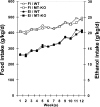
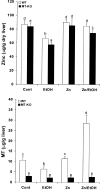
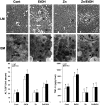
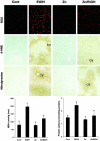

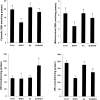
Similar articles
-
Chronic ethanol consumption results in atypical liver injury in copper/zinc superoxide dismutase deficient mice.Alcohol Clin Exp Res. 2010 Feb;34(2):251-61. doi: 10.1111/j.1530-0277.2009.01088.x. Epub 2009 Nov 30. Alcohol Clin Exp Res. 2010. PMID: 19951287
-
Zinc prevention and treatment of alcoholic liver disease.Mol Aspects Med. 2005 Aug-Oct;26(4-5):391-404. doi: 10.1016/j.mam.2005.07.002. Mol Aspects Med. 2005. PMID: 16099027 Review.
-
Alleviation of alcoholic liver injury by betaine involves an enhancement of antioxidant defense via regulation of sulfur amino acid metabolism.Food Chem Toxicol. 2013 Dec;62:292-8. doi: 10.1016/j.fct.2013.08.049. Epub 2013 Aug 27. Food Chem Toxicol. 2013. PMID: 23994088
-
Apigenin protects against alcohol-induced liver injury in mice by regulating hepatic CYP2E1-mediated oxidative stress and PPARα-mediated lipogenic gene expression.Chem Biol Interact. 2017 Sep 25;275:171-177. doi: 10.1016/j.cbi.2017.08.006. Epub 2017 Aug 10. Chem Biol Interact. 2017. PMID: 28803762
-
Role of oxidative stress in alcohol-induced liver injury.Arch Toxicol. 2009 Jun;83(6):519-48. doi: 10.1007/s00204-009-0432-0. Epub 2009 May 16. Arch Toxicol. 2009. PMID: 19448996 Review.
Cited by
-
The use of selected nutrition supplements and complementary and alternative medicine in liver disease.Nutr Clin Pract. 2006 Jun;21(3):255-72. doi: 10.1177/0115426506021003255. Nutr Clin Pract. 2006. PMID: 16772543 Free PMC article. Review.
-
The Role of Vitamin Deficiency in Liver Disease: To Supplement or Not Supplement?Nutrients. 2021 Nov 10;13(11):4014. doi: 10.3390/nu13114014. Nutrients. 2021. PMID: 34836267 Free PMC article. Review.
-
Chronic Alcohol Exposure Induced Neuroapoptosis: Diminishing Effect of Ethyl Acetate Fraction from Aralia elata.Oxid Med Cell Longev. 2019 May 9;2019:7849876. doi: 10.1155/2019/7849876. eCollection 2019. Oxid Med Cell Longev. 2019. PMID: 31210848 Free PMC article.
-
Zinc and alcoholic liver disease.Dig Dis. 2010;28(6):745-50. doi: 10.1159/000324282. Epub 2011 Apr 27. Dig Dis. 2010. PMID: 21525759 Free PMC article. Review.
-
Assessment of the Mitigative Capacity of Dietary Zinc on PCB126 Hepatotoxicity and the Contribution of Zinc to Toxicity.Chem Res Toxicol. 2016 May 16;29(5):851-9. doi: 10.1021/acs.chemrestox.6b00022. Epub 2016 Mar 23. Chem Res Toxicol. 2016. PMID: 26967026 Free PMC article.
References
-
- Kiilerich S, Dietrichson O, Loud FB, Naestoft J, Christoffersen P, Juhl E, Kjems G, Christiansen C. Zinc depletion in alcoholic liver diseases. Scand J Gastroenterol. 1980;15:363–367. - PubMed
-
- McClain CJ, Antonow DR, Cohen DA, Shedlofsky S. Zinc metabolism in alcoholic liver disease. Alcohol Clin Exp Res. 1986;10:582–589. - PubMed
-
- Bode JC, Hanisch P, Henning H, Koenig W, Richter FW, Bode C. Hepatic zinc content in patients with various stages of alcoholic liver disease and in patients with chronic active and chronic persistent hepatitis. Hepatology. 1988;8:1605–1609. - PubMed
-
- Dinsmore W, Callender ME, McMaster D, Todd SJ, Love AH. Zinc absorption in alcoholics using zinc-65. Digestion. 1985;32:238–242. - PubMed
-
- Valberg LS, Flanagan PR, Ghent CN, Chamberlain MJ. Zinc absorption and leukocyte zinc in alcoholic and nonalcoholic cirrhosis. Dig Dis Sci. 1985;30:329–333. - PubMed
Publication types
MeSH terms
Substances
Grants and funding
LinkOut - more resources
Full Text Sources
Other Literature Sources
Medical
Molecular Biology Databases

